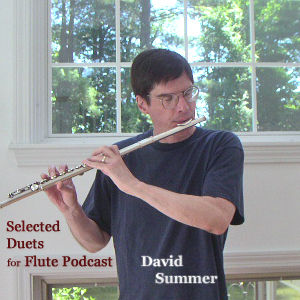
Selected Duets for Flute Podcast
David Summer
David Summer plays Selected Duets for Flute. Using his home recording studio, David has recorded some of the duets from the book Selected Duets for Flute, Volume 1 Edited by H.Voxman. These flute duets are standard learning material for flute students taking flute lessons and can be fun to play for all flutists. In addition to being educational, the duets can also be used by two flutes in performance. They are especially effective for wedding ceremonies, church services and other occasions calling for elegant music. This podcast contains the recordings of both flute parts, played as a duet. As a resource for flute students and flute teachers, David has also recorded each of these duets in a flute 2 only version that can be used as a play along. The matching flute 2 only version for each of these recordings can be found on the Flute Podcast page of David's website at www.summersong.net.
- 1 minute 11 secondsPage69 #2, WaltzSelected Duets for Flute, Page 69 Number 2, Waltz, performed by David Summer. A waltz is a ballroom dance in triple meter (usually 3/4 time). Couples dance close together, with the man's right hand on the woman's back or around her waist. The tempo marking for this duet, "Allegro vivace", indicates a tempo that's faster than an Allegro. This fast tempo is commonly found in waltzes originating in Vienna. Austrian composer, Johann Nepomuk Hummel, was also a virtuoso pianist. His style of writing bridges the classical and romantic musical periods, with most of his pieces being, naturally enough, for piano. He wrote several pieces for multiple pianos, also operas, masses and more. Hummel's Trumpet Concerto in Eb, is part of the standard performance literature for trumpet. It's a very melodic piece, well worth searching out. The metronome setting for this performance is half note = 144.20 December 2009, 12:00 pm
- 1 minute 23 secondsPage68 #1e, Rigodon II from Sonata VI, Op.5Selected Duets for Flute, Page 68 Number 1e, Rigodon II from Sonata VI, Op.5, performed by David Summer. This second Rigodon presents a good opportunity for the teacher to talk about arpeggios, since the second flute part is littered with them. For both of these rigadoon duets, the student should practice both flute parts. Teacher and student might even exchange parts on the repeats. The metronome setting for this performance is half note = 80.6 December 2009, 12:00 pm
- 1 minute 16 secondsPage68 #1d, Rigodon I from Sonata VI, Op.5Selected Duets for Flute, Page 68 Number 1d, Rigodon I from Sonata VI, Op.5, performed by David Summer. The title of this duet, "Rigodon" is a variant on the spelling of rigadoon. A rigadoon is a dance for two couples in quick double time. The rigadoon originated in Provence, France, in the 15th-century and is named after a dancing master from Marseilles. It became popular at the court of Louis XIV from the 1670s and spread to most of the courts of Europe. Couples dance side by side without holding hands and at certain moments make a springing step called the pas de rigaudon. The metronome setting for this performance is half note = 88.22 November 2009, 12:00 pm
- 1 minutePage67 #1c, Adagio from Sonata VI, Op.5Selected Duets for Flute, Page 67 Number 1c, Adagio from Sonata VI, Op.5, performed by David Summer. This third movement from Sonata VI, Op.5, by Johann Quantz changes to the key of G major (the relative major to e minor). It's slow enough so that performers are advised to count eight notes as getting one beat, as I do for this performance. Quantz was not only a prolific composer of music for the flute, as well as the author of the afore mentioned book "On Playing the Flute", he also made flutes of his own design. Probably the most famous recipient of these instruments was King Frederick the Great. Quantz built many flutes for Frederick while serving the King. To modern western musicians, Quantz's most interesting addition to his flute is a key for D# even though the enharmonic Eb key was already present on the flute, as it is today. This was to satisfy the desire to play using a system called "just intonation", which was prevalent until about the middle of the 19th century, before the widespread adoption of the "equal temperament" system most widely used in western music today. The metronome setting for this performance is eigth note = 88.8 November 2009, 12:00 pm
- 1 minute 20 secondsPage66 #1b, Allegro from Sonata VI, Op.5Selected Duets for Flute, Page 66 Number 1b, Allegro from Sonata VI, Op.5, performed by David Summer. This second movement from Sonata VI, Op.5, by Johann Quantz retains the key of e minor from the first movement but this movement is a lively Allegro. In addition to numerous musical compositions for flute, Quantz is also the author of a seminal musical treatise for the instrument entitled "On Playing the Flute". "On Playing the Flute" belies its title by containing not only a wealth of information on flute playing, but also by covering a wide range of subjects including breath control and musical accompaniment as well as more general musical topics such as performance anxiety. The book was used by his students as the basis for a "school of flute playing" and remains relevant today. It is still in print and makes a worthy addition to any flutist's library. There are no repeats in this performance and the metronome setting is dotted quarter note = 66.25 October 2009, 12:00 pm
- 1 minute 13 secondsPage66 #1a, Adagio from Sonata VI, Op.5Selected Duets for Flute, Page 66 Number 1a, Adagio from Sonata VI, Op.5, performed by David Summer. Johann Joachim Quantz is a name that is well known by professional flutists as well as advanced flute students. Quantz wrote over 300 concertos and many flute sonatas. This duet is from one of his early efforts, Sonata VI, Op.5. He also wrote many collections of flute duets, probably the most popular today being his "Six Duets For Two Flutes Op.2". Although he traveled widely, studying music in the first half of his life, Quantz spent his last 30 years, from 1741 to his death in 1773, in Dresden under the service of King Frederick the Great of Prussia. This recording is the first of 5 movements of the Sonata. The other 4 movements will be presented over the next 4 podcast episodes. The metronome setting for this performance is quarter note = 69.11 October 2009, 12:00 pm
- 1 minute 38 secondsPage65 #20, MinuetSelected Duets for Flute, Page 65 Number 20, Minuet from Duettino, Op.42,No.8, performed by David Summer. This Minuet, by James Hook, is from his collection of short flute duets entitled "12 Duettinos, Op. 42". (Duettino meaning a short or concise duet.) James Hook was a prolific English baroque composer, composing what may have been the first clarinet concerto written by an English composer. Like many baroque composers, he was a church organist and used the instrument as a compositional aid. James Hook was an extremely popular and successful composer. Hook became wealthy from his compositions, he encouraged young musicians and he was noted as a generous and jovial family man. The second repeat is omitted from this performance and the metronome setting is quarter note = 100.27 September 2009, 12:00 pm
- 1 minute 52 secondsPage64 #19, AllegrettoSelected Duets for Flute, Page 64 Number 19, Allegretto, performed by David Summer. This piece is an Allegretto, which again is a moderately fast tempo between Allegro and Moderato. Like many of the previous duets, this one also has some imitative characteristics. This duet is either by Henry Eccles or his brother John Eccles, both of whom were English baroque composers. The metronome setting for this performance is half note = 76.13 September 2009, 12:00 pm
- 1 minute 57 secondsPage62 #18, FugatoSelected Duets for Flute, Page 62 Number 18, Fugato, performed by David Summer. A fugue is an imitative piece, similar to a cannon. A main difference between a fugue and a cannon is that in a fugue, the second voice part comes in a fifth away from the first voice part. This duet is a fugato, which is not strictly a fugue, but retains much of the style of a fugue. The composer of this duet, Johann Wenzel Anton Stamitz, was a Czech composer and violinist. Johann Stamitz, like Telemann, contributed to the transition of the baroque period to the classical era. Many members of the Stamitz familiy were composers, including Johann’s two sons Carl and Anton. Johann Stamitz was a founder of the Mannheim school. This style of music composition introduced many of the musical concepts that help to distinguish the baroque from the classical period, including dynamic innovations such as the crescendo. The metronome setting for this performance is half note = 100.16 August 2009, 12:00 pm
- 2 minutes 12 secondsPage60 #17, MenuettSelected Duets for Flute, Page 60 Number 17, Menuett, performed by David Summer. The title of this duet, "Menuett", is yet another spelling variation on the word "Minuet". The two flute parts are largely independent rhythmically. By the time a student gets to this part of the book, they should be getting fairly comfortable with rhythmically independent parts though. The tempo marking, Allegro molto, means very fast. But the duet should still be played in the context of a "Minuet" dance. There are no repeats taken and the metronome setting for this performance is quarter note = 132.2 August 2009, 12:00 pm
- 1 minute 2 secondsPage59 #16, Menuet ItalianSelected Duets for Flute, Page 59 Number 16, Menuet Italian, performed by David Summer. This is the third, and last, duet by composer and musette virtuoso, Nicolas Chédeville. It's from the same sonata, Sonata Number 6, Opus 8, as the previous duet. The meter is 3/8 and it's played with a feeling of being "in 1". This is much the same as 6/8 played "in 2" as many of the previous duets have been. The metronome setting for this performance is eigth note = 126.19 July 2009, 12:00 pm
- More Episodes? Get the App
- http://www.summersong.net
- English
Your feedback is valuable to us. Should you encounter any bugs, glitches, lack of functionality or other problems, please email us on [email protected] or join Moon.FM Telegram Group where you can talk directly to the dev team who are happy to answer any queries.
 Learn Flute Podcast
Learn Flute Podcast
 Flute podcast from Magnatune.com
Flute podcast from Magnatune.com
 Talking Flutes
Talking Flutes
 VSM: Flute Lessons
VSM: Flute Lessons